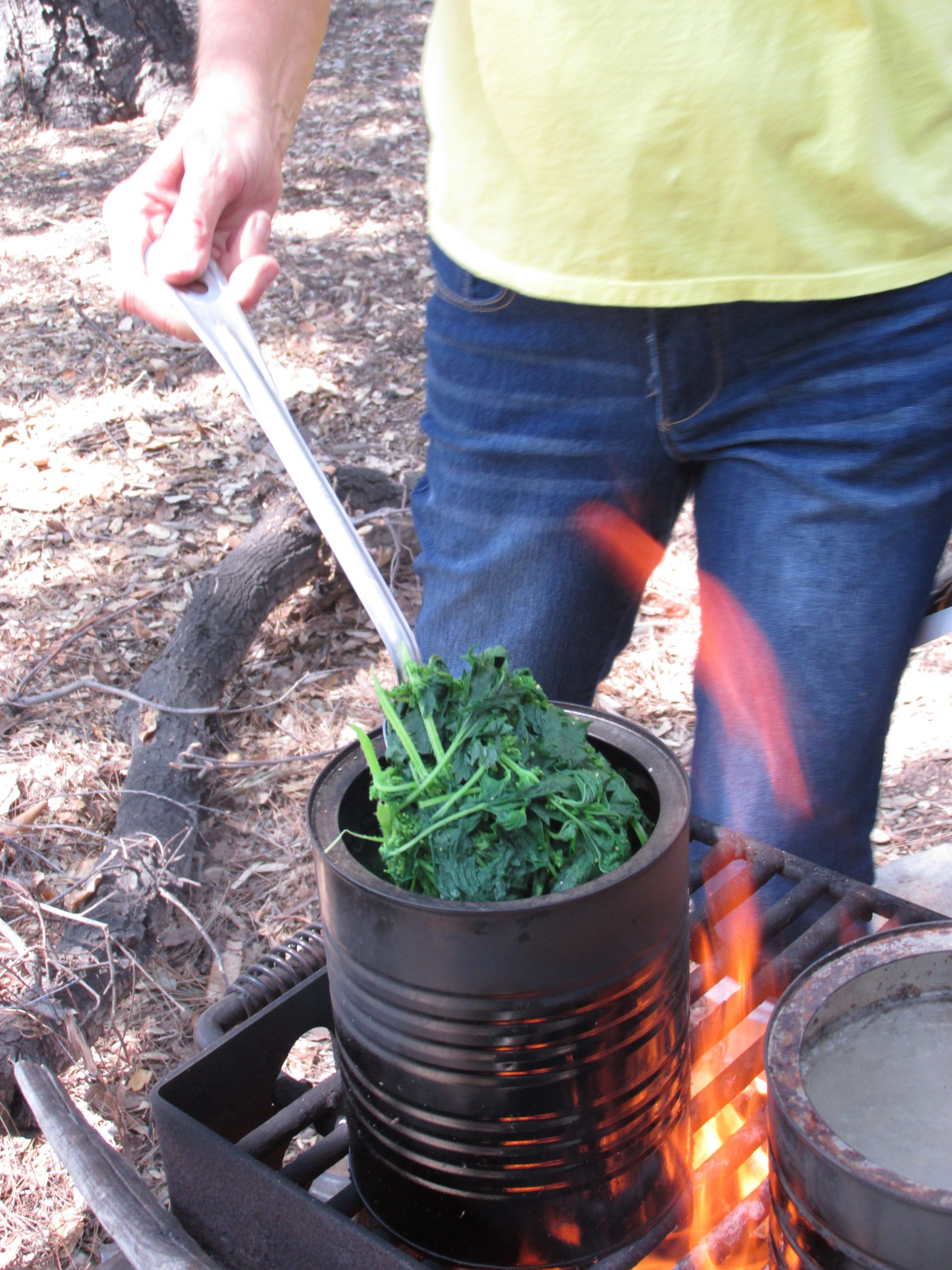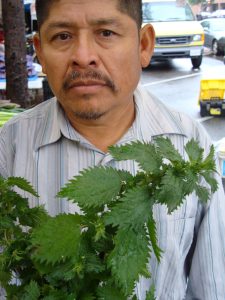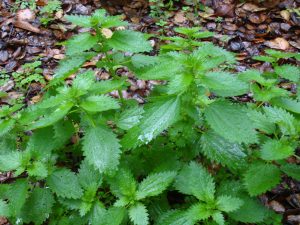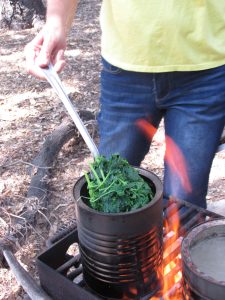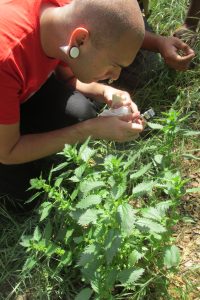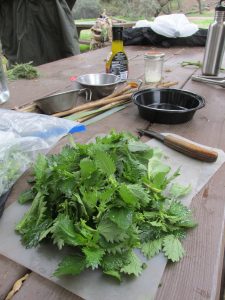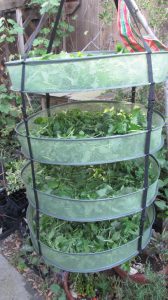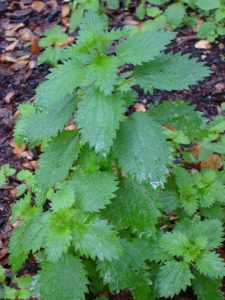ENJOY THE DELICIOUS WILD NETTLE PLANT:
An excellent food, medicine, and fibre source
By Christopher Nyerges
[Nyerges is the author of “Guide to Wild Foods,” “How to Survive Anywhere,” “Foraging California” and others. He has led Wild Food Outings since 1974, and he lectures and writes on natural sciences and ethno-botany widely. His website is www.SchoolofSelf-Reliance.Nyerges.com, or he can be reached at School of Self-Reliance, Box 41834, Eagle Rock, CA 90041]
With this year’s rains, there has been an abundance of the nettles plant, among many other common wild herbs.
Though widely regarded as a “nuisance plant,” indigenous peoples of California commonly used the native nettle plant for food. It was one of the favorite foods of Barbara Drake, a Tongva elder. (The Tongva are the indigenous people of the greater Los Angeles County area). “I love to cook with nettles,” said Drake, who was renowned for her nettle and sunflower seed soup, which she would make and serve at large gatherings.
Adrian Gaytan sells nettles (“hortiga” in Spanish) at farmers markets.
Drake’s students always loved her nettle soups, which were also nutritionally-based. According to the USDA’s Composition of Foods, 100 grams of nettle contains 6,500 I.U. of Vitamin A, and 76 mg. of Vitamin C. This amount contains 481 mg. of calcium, 71 mg. of phosphorus, and 334 mg. of potassium. This amount also contains 5.5 grams of protein, a lot for greens, though not complete protein.Writing in the book that she co-authored, “Cooking the Native Way,” Drake describes her famous nettle soup. “Always use gloves or tongs when handling fresh nettle,” advises Drake.
“In a soup pot, sautee 3 minced garlic cloves, and one diced medium onion in 3 tablespoons of olive oil. Add two quarts of broth or water (low sodium chicken broth, or vegetable broth), and two cups of raw, unsalted shelled sunflower seeds. Add an herb bundle (three-inch sprig of thyme, sage, rosemary, and one bay leaf). Simmer for 20 minutes until the sunflower seeds soften. Add two handfuls of fresh nettles (or one cup dried), and simmer for an additional 15 to 20 minutes. Remove the herb bundle and serve.”
A view of the stinging nettle plant.
Most people who enjoy nettles cook the greens in some variation of the Drake recipe, often simply boiling and serving with butter. In many of the records of the depravities of WWII, survivors speak of food shortages, and how nettles were commonly used to make meals. Europeans who lived through WWII, such as the esteemed botanist Dr. Leonid Enari, have reported that people survived the hardships of World War II by eating wild nettles and cattails.
Nettle leaves cooked like spinach at a camp.
David Moerman, in his classic “Native American Ethnobotany,” catalogs the many food, medicinal, and utilitarian uses of both the native and the introduced nettle plant by Native Americans. Nearly all the groups he profiles have used the nettle greens for food, once cooked. Most have also used the fibre of the mature stalks for basketry, mats, and cordage. And a surprisingly large number of tribes used the fresh nettle to swat on the skin, as a temporary relief to the pain of rheumatism.
Stinging nettle (Urtica dioeca) is a fairly common plant throughout most of North America, which originated in Europe and is now widely found in the wild and in back yards. Native nettles (Urtica holosericea), also called “creek nettle,” is a taller and more robust plant than the European variety, though the European nettle is far more widespread. Both can be used in all the ways described here.
Student Ryan examines the “stingers” on the nettle plant.
The reason why so many people dislike “stinging” nettles is because when you brush up against it, you break off the tips of tiny hollow needles that are filled with formic acid, and you get a stinging reaction.
Nicholas Hummingbird, of Chumash-Cahuilla roots, talks about his first experience with nettle in “The Ethnobotany Project.” He says, “I’ll never forget the first time I accidentally touched (nettle). Man, did I hurt! But you know what I found out? You take a mugwort leaf and you rub it on the sting, and it takes it away.” According to herbalists, you can remove the sting of nettles by rubbing the skin with many herbs including mugwort, chickweed, curly dock, or even wild grasses.
Stinging nettles that have been washed, de-stemmed, and made ready for soup.
Herbalist Michael Moore, author of Medicinal Plants of the Mountain West, describes nettles as a diuretic and astringent, and he advises the tea for use in cases of internal bleeding. Nettle tea is used by herbalists for common allergies, such as those which result from being around excessive pollen in the spring and summer. There is widespread anecdotal evidence that suggests Nettle tea is useful for allergies.
A drying rack is one of the ways to dry nettles for future use.
According to Enrique Villasenor, co-author of “Healing with Medicinal Plants of the West” with Dr. James Adams, “A healthy prostate is critical for all men, especially as we age. BPH (Benign Prostatic Hyperplasia) is a common disease in 90% of men over 60. Research shows 50% of men between the ages of 51 to 60, and 90% of men over 80, have been diagnosed with BPH. Nettle is the most commonly used herbal remedy because of its anti-inflammatory, anti-tumor, and anti-viral effects. It also helps enhance and regulate the immune system. Nettle helps relieve the symptoms of BPH because it contains compounds such as phytosterols, lignans, and polysaccharides. Phytosterols help you manage blood cholesterol levels. Lignans possess a steroid-like chemical structure. Polysaccharides stimulate your body to produce anti-tumor, anti-inflammatory, anti-microbial, and anti-viral activities. Some research also indicates that Nettle may be useful in fighting HIV infections, herpes, and hepatitis viruses.”
A view of stinging nettles in the field.
In general, nettles are found growing in the wild near streams, in moist soil, in rich soil, and often near raspberries and blackberry vines. And in the urban areas, it seems to grow everywhere: along roads, in fields, backyards, gardens, and even in the cracks of urban sidewalks. Although gardeners and city workers weed-whack this herb into oblivion every spring, health enthusiasts go to places like Whole Foods and pay $10 a box for the very same “nuisance weeds” that were probably growing in their own backyards.

